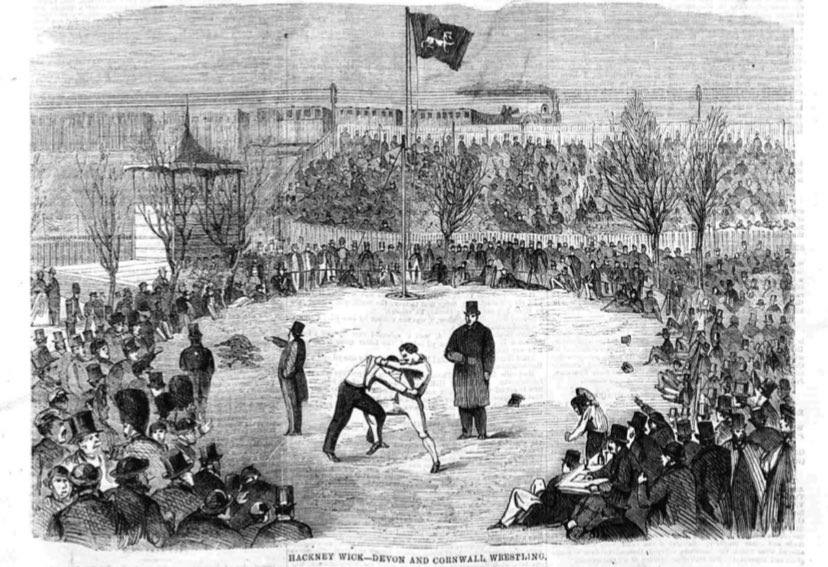Cornish wrestling stands as one of Britain’s oldest and most intriguing martial arts, with roots extending deep into Celtic antiquity. While many traditional sports have faded into obscurity, this distinctive form of combat has maintained its authentic character through centuries of practice and refinement. From its mythical origins with the giant-slaying Corineus to its patronage by kings and nobles, the art of Cornish wrestling weaves together elements of skill, strategy, and cultural pride. The subtle complexities of its techniques and the dramatic stories behind its champions reveal a fascinating narrative that continues to unfold in modern times.
Key Takeaways
- Cornish Wrestling is an ancient Celtic martial art where wrestlers wear special jackets and aim to throw opponents onto their backs.
- Matches take place on grass within two concentric circles, supervised by three officials called “sticklers.”
- Victory is achieved by scoring a “back,” where the opponent is thrown cleanly with three or four points of contact on the ground.
- The sport has royal connections, including King Henry VIII’s famous match against Francis I in 1520.
- Traditional techniques include the Back Heave, Fore Heave, Under Heave, and Cornish Hug, with all holds permitted only above the waist.
Ancient Origins and Heritage
Nearly five thousand years of history shape Cornish Wrestling, with its earliest documented roots traced to the ancient book of Leinster and the Tailteann Games around 1829 BC. The sport’s Celtic influence is evident through its shared characteristics with other Celtic wrestling traditions, particularly the Breton gouren and Irish collar and elbow styles, suggesting a common ancestral origin.
During the 4th and 5th centuries AD, indigenous Britons from Cornwall and Devonshire migrated to what is now Brittany, bringing their cultural rituals and wrestling traditions with them. Archaeological evidence, including a carved roof boss from around 1300 AD and similar Irish carvings dating to 800 AD, provides tangible proof of wrestling’s historical presence in Cornwall. Michael Drayton’s poem Polyolbion in 1590 marks the first written documentation of wrestling in the West Country region.
The sport’s ancient heritage is further supported by literary references, such as Geoffrey of Monmouth’s writings from 1139, and legendary tales like the story of Corinaeus defeating Gog Magog. While some of these stories may be more mythological than historical, they demonstrate wrestling’s deep-rooted significance in Cornish culture and its continuous presence throughout the region’s history.
The Legendary Corineus Legacy
According to medieval literature, Corineus, a Trojan warrior of modest stature but extraordinary strength, established himself as the first legendary champion of Cornish wrestling. His most famous feat involved wrestling and defeating the giant Goemagog, whom he threw from a cliff in a display of remarkable power and skill. This legendary tale, recorded in Geoffrey of Monmouth’s Historia Regum Britanniae, became a cornerstone of Cornish wrestling heritage and continues to symbolize the strength and resilience of Cornwall’s athletic traditions. The first officially documented competitions between Cornwall and Brittany would not take place until 1402, marking the beginning of recorded matches in this ancient sport.
Ancient Tales of Strength
The legendary tale of Corineus stands as one of the most significant ancient narratives in Cornish wrestling history. As a descendant of the Trojans, Corineus demonstrated exceptional strength and bravery in his famous encounter with mythical giants, particularly in his wrestling match against Gogmagog. This epic battle, which ended with Corineus throwing the giant from the cliffs near present-day Plymouth, became a powerful symbol of triumph and cultural symbolism in Cornish folklore.
According to Geoffrey of Monmouth’s Historia Regum Britanniae, Corineus joined Brutus in his journey to Albion, where they encountered a land inhabited by giants. While Brutus and his army defeated most of these creatures, they preserved Gogmagog specifically for a wrestling contest with Corineus. Following his victory, Corineus was awarded the southwestern peninsula of Britain, which became known as Cornwall in his honor. His reputation as a moderate man in council but fierce in battle established him as the first Duke of Cornwall, cementing his place in the region’s historical narrative and contributing to Cornwall’s distinct cultural identity. The defeat of Gogmagog exemplified the primary objective of Cornish wrestling, which requires throwing an opponent to land flat on back.

Wrestling’s First Champion
Legendary Corineus, celebrated as wrestling’s first champion in Cornish history, established a profound martial legacy that would influence the region’s cultural identity for centuries to come. As a descendant of the Trojans and companion to Brutus, Corineus’s exploits became central to the founding mythology of Cornwall, where he served as its first Duke. His military prowess was proven when he helped defeat King Goffarius Pictus in battle.
His most famous achievement was the epic wrestling match against the giant Gogmagog near modern-day Plymouth. The contest, which ended with Corineus throwing his massive opponent from the cliffs, demonstrated his exceptional strength in spite of his medium stature. This dramatic victory became a cornerstone of Cornish folklore and wrestling traditions.
Corineus’s influence extends beyond mythology into the practical development of Cornish wrestling as a distinctive cultural practice. The sport, which features unique grappling techniques, evolved into a recognized national pastime of Cornwall. His legacy lives on through traditional wrestling competitions between Cornwall and Brittany, highlighting the enduring Celtic connections. The story of Corineus, recorded in Geoffrey of Monmouth’s Historia Regum Britanniae, continues to inspire modern practitioners of this ancient sport.
Royal Recognition through History
Throughout history, Cornish wrestling has enjoyed significant royal patronage, with monarchs not only supporting the sport but actively participating in matches. Historical tournaments attracted notable royal spectators, including King Charles II, who praised Cornish wrestlers during a competition at Bodmin. King Henry VIII himself participated in matches, famously wrestling against Francis I at the Field of the Cloth of Gold in 1520.
The sport’s royal connections strengthened through various forms of support:
- The Prince of Wales provided long-term backing to the Cornwall and Devon Wrestling Society
- The Duke of Cornwall offered financial assistance to the Cornish Wrestling Association
- Lord St Levan and Viscount Clifden served as influential royal patrons
- Sir Arthur William Buller became a patron in 1868, followed by other notable figures
This royal recognition helped establish Cornish wrestling as a respected sporting tradition. References to these noble competitions date back to Geoffrey of Monmouth in 1139, showcasing the sport’s deep historical roots. The sport’s prominence was further demonstrated at significant historical events, such as the Battle of Agincourt in 1415, where Cornish wrestlers marched under their distinctive banner. Even Oliver Cromwell acknowledged the wrestlers’ skill during a match he attended in Hyde Park in 1654.
Rules and Match Dynamics
Cornish wrestling matches operate under the supervision of three officials called sticklers, who oversee the contest from a ring marked with two concentric circles on flat grass. The primary goal is to achieve a “Back,” where the opponent lands with three or four points of contact (shoulders and hips) touching the ground simultaneously, resulting in an immediate victory. Wrestlers must follow strict rules about gripping the jacket only, avoiding kicks above the knee, and maintaining continuous engagement, as non-combativity can result in warnings and point deductions. The sport requires wrestlers to compete barefoot in shorts and wear a regulation jacket during all matches.
Match Officials and Setup
Every official match in Cornish Wrestling is overseen by three registered judges known as “sticklers,” who are typically former wrestlers themselves. These officials carry important responsibilities in ensuring fair play and maintaining order throughout the match. Their duties include keeping score, determining when a back occurs, and identifying any rule violations during the contest. Points are deducted when wrestlers commit serious foul moves like the cross collar or crowbar hitch.
The match setup follows strict guidelines regarding the competition area and equipment. Matches take place on flat grass within two concentric circles, with the inner circle measuring at least twelve meters in diameter and the outer circle extending four meters beyond that. Wrestlers must compete in specified attire:
- Bare or stockinged feet
- Sports shorts
- Regulation wrestling jacket
- Female wrestlers must wear a leotard underneath
The sticklers oversee vital match procedures, including the mandatory handshake before and after each bout. When any part of a wrestler’s body except their feet touches the ground, the sticklers declare the hitch “broken,” requiring the wrestlers to stop, shake hands, and begin again. The term “stickler” itself has historical significance, believed to derive from Old English and associated with their ceremonial stick.
Hold Types and Scoring
Traditional wrestling matches in Cornwall center on a complex scoring system and a specific set of permitted holds that emphasize control and technique above the waist. The hold techniques focus exclusively on gripping the wrestler’s jacket, with flat-handed pushing or deflecting allowed, while any holds below the waist or on the throat are strictly prohibited. These restrictions align with the historical Cwdwm Braich style that emphasized wrestling at arms length.
The primary hold techniques include the Back Heave, Fore Heave, Under Heave, and Cornish Hug, each requiring precise execution and body positioning. Wrestlers compete barefoot and must maintain proper grip on their opponent’s jacket throughout the match. The scoring methods are based on a pin system, where points are awarded depending on how many of the four pins on a wrestler’s back touch the ground during a throw.
A match can be won instantly by achieving a “back,” which occurs when a wrestler is thrown cleanly onto their back. If no back is scored within the two ten-minute rounds, the winner is determined by accumulated points. Sticklers, who serve as officials, can deduct points for fouls such as intentionally slipping out of the jacket or using illegal holds.
Victory and Fair Play
The victory conditions in Cornish Wrestling are governed by a structured system of rules and officiated by experienced judges known as sticklers. Victory strategies often focus on achieving a “back,” where an opponent is thrown flat with three points of contact on the ground, immediately ending the match. When no back occurs, points are awarded based on successful throws, with one point for a single pin and two points for two pins.
Fair play principles are fundamental to the sport, with strict regulations governing conduct and equipment. Wrestlers must:
- Wear proper Cornish Wrestling jackets and compete barefoot
- Grip only the opponent’s jacket, avoiding holds below the waist
- Exchange handshakes during match interruptions and after bouts
- Avoid intentional fouls, such as slipping out of the jacket
Match decisions are determined by the sticklers’ scorecards, with winners needing majority approval from at least two of the three officials. If no points are scored during a match, the wrestler demonstrating the most active play receives a point. Penalties for rule violations include point deductions, with three marks resulting in the loss of one point.
Global Spread and Development
Since its ancient origins predating the Roman invasion, Cornish wrestling has evolved from a regional sport into an internationally recognized martial art. The establishment of annual tournaments between Cornish and Breton wrestlers in 1927 marked a significant milestone in global tournaments, leading to increased cultural exchanges between different wrestling communities. Notable champions like Henry Randall Neilson helped raise the sport’s international profile during the late 19th and early 20th centuries.
The sport’s expansion has been particularly notable through the Cornish diaspora, which introduced wrestling traditions to countries including Australia, Brazil, and South Africa. Various organizations, such as the Royal Marine Light Infantry and the Cornish Association of South Africa, have played essential roles in organizing international competitions. The sport’s governance structure evolved significantly in the 1920s, addressing earlier challenges where multiple wrestlers simultaneously claimed championship titles. Today, Cornish wrestling events are hosted worldwide, encouraging cross-cultural understanding and preserving traditional techniques. The sport’s international development has been supported by regional committees and governing bodies, ensuring its continued growth while maintaining its cultural authenticity and historical significance. The sport’s rich heritage is exemplified by its presence at the Battle of Agincourt in 1415, where Cornish wrestlers fought under their own distinctive banner.
Championship Matches and Notable Wrestlers
Throughout Cornish wrestling’s rich history, championship matches have shaped the sport’s legacy and created legendary figures within its ranks. Historical rivalries emerged as early as 1826, with the notable draw between Polkinghorne and Abraham Cann under Devonian rules. The championship evolution continued through the 1800s, marked by significant matches that established the sport’s competitive structure.
Several wrestlers have left a lasting mark on the sport’s history:
- Francis St Clair Gregory dominated as heavyweight champion for seven consecutive years, representing Cornwall in matches against Brittany
- William Hodge achieved success in both UK and Australia, claiming the Australian title in 1851
- John Charles Corse, known as the “Sydney Champion,” secured the Australian title in 1852
- Roy St Clair, following in his father’s footsteps, gained recognition by defeating renowned wrestlers like André the Giant
Francis St Clair Gregory, who began his wrestling journey at age 13, remained undefeated in Cornu-Breton tournaments seven times across both Cornwall and Brittany. The sport’s competitive legacy continues today through the Cornish Wrestling Association, which organizes tournaments across Cornwall. Modern champions like Ashley Cawley, the current Heavyweight Champion of Cornwall, maintain the tradition of excellence established by their predecessors, while the association works to preserve and promote this historical sport.

